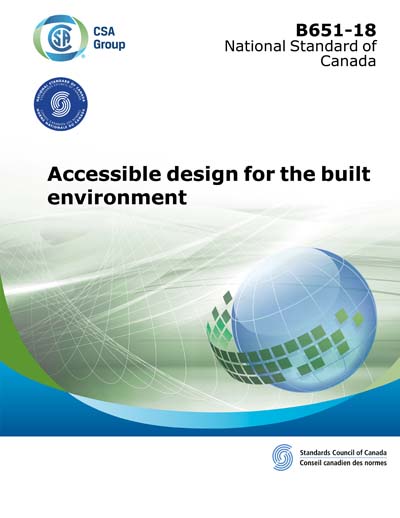Historical
CSA B651-2018
Accessible design for the built environment
Preface This is the fifth edition of CSA B651, Accessible design for the built environment. It supersedes the previous editions published in 2012 and 2004 under the same title, and the 1995 and 1990 editions published under the title, Barrier-free design. This edition of the Standard has been reformatted without the informative Commentary. The Commentary is now available in CSA B651HB-18, Accessible design for the built environment – Implementation Handbook. The technical requirements in this Standard are minimum levels. They represent a consensus of the Technical Committee members, who represent a broad spectrum of interests. The members are helped and encouraged by the public comments received as a result of the wide distribution of a draft at the public review stage. The Technical Committee on Accessibility has also produced two related Standards, CSA B651.1, Accessible design for automated banking machines, and CAN/CSA-B651.2, Accessible design for self-service interactive devices. The Technical Committee has also developed other Standards, including a) CSA B480, Customer service standard for people with disabilities; b) CSA B659, Inclusive design for an aging population; and c) the adoption, CAN/CSA-ISO IWA 18, Framework for integrated community-based life-long health and care services in aged societies. Significant changes to this edition include the following: a) expansion of requirements to accommodate the full range of wheeled mobility devices, including manual and powered wheelchairs, and scooters; b) updates to dimensions based on current data from anthropometric research; c) alignment of design requirements with the accessible design section of the National Building Code of Canada; d) updated requirements for exterior environments; and e) a new informative annex on trails and beach access routes. This Standard has been developed in compliance with Standards Council of Canada requirements for National Standards of Canada. It has been published as a National Standard of Canada by CSA Group. Scope 1.1 Purpose This Standard specifies technical requirements on how to make buildings and the exterior built environment accessible and safely usable by persons with physical, sensory, or cognitive disabilities. 1.2 Application This Standard describes technical requirements that can be used in the design and construction of new facilities or exterior environments, or in modifications to existing facilities. This Standard does not address the application of the technical requirements. The extent to which these requirements have to be applied is the responsibility of other authorities having jurisdiction. 1.3 Dimensions This Standard contains minimum requirements based on adult dimensions. Dimensions are given in SI (metric) units (typically in millimetres) and, where converted from foot/ pound (imperial) units, have been rounded off with respect to critical dimensions. All dimensions in figures are given in millimetres and are measured to the centerline, unless otherwise specified. 1.4 Figures Figures are included for explanatory or illustrative purposes only and are not a mandatory part of the Standard. Figures are not to scale. If there is any difference between the text and figure (where provided), the text shall take precedence. 1.5 Annexes Annexes A to C provide additional information on topics considered in the Standard. Annex D provides guidance for the design of outdoor trails and beach access routes. Annex E contains references for accessible outdoor recreational environments, to supplement the information and guidance provided in Annex D. 1.6 Terminology In this Standard, "shall" is used to express a requirement, i.e., a provision that the user is obliged to satisfy in order to comply with the standard; "should" is used to express a recommendation or that which s advised but not required; and "may" is used to express an option or that which is permissible within the limits of the standard. Text accompanying tables and figures are considered part of the table or figure and may be written as requirements. Annexes are designated normative (mandatory) or informative (non-mandatory) to define their application. 1.7 Large print Consistent with the recommendations of the CSA B651 series of standards, and for ease of reading the information and universal accessibility, this Standard has been printed in a 14 point font size.
Content Provider
CSA America, Inc. [csa]






